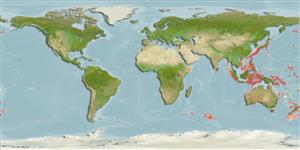>
Anguilliformes (Eels and morays) >
Muraenesocidae (Pike congers)
Etymology: Gavialiceps: Hindi, ghariyal = gavial, saurian of Ganges, 1825 + Greek, kephale = head (Ref. 45335); javanicus: Named after its type locality (Ref. 44791).
Environment: milieu / climate zone / depth range / distribution range
Ökologie
seewasser bathydemersal; tiefenbereich 560 - 600 m (Ref. 44791). Deep-water
Indo-West Pacific: Java, Indonesia and northwestern Australia.
Size / Gewicht / Alter
Maturity: Lm ? range ? - ? cm
Max length : 89.0 cm TL Männchen/unbestimmt; (Ref. 44791)
Kurzbeschreibung
Bestimmungsschlüssel | Morphologie | Morphometrie
Dark brown, the back is darker than the belly. Peritoneum, gill and mouth cavities are dark and show through the skin. Stomach is bright, does not reach above the anus, its length is 2.1 times the length of the head (Ref. 44791).
Life cycle and mating behavior
Geschlechtsreife | Fortpflanzung | Ablaichen | Eier | Fecundity | Larven
Karmovskaya, E.S., 1994. Systematics and distribution of the eel genus Gavialiceps (Congridae) in the Indo-West Pacific. J. Ichthyol. 34(3):73-89. (Ref. 44791)
IUCN Rote Liste Status (Ref. 130435: Version 2024-2)
Bedrohung für Menschen
Harmless
Nutzung durch Menschen
Tools
Zusatzinformationen
Download XML
Internet Quellen
Estimates based on models
Preferred temperature (Ref.
123201): 2 - 8.8, mean 7.6 °C (based on 26 cells).
Phylogenetic diversity index (Ref.
82804): PD
50 = 0.5313 [Uniqueness, from 0.5 = low to 2.0 = high].
Bayesian length-weight: a=0.00155 (0.00068 - 0.00355), b=2.92 (2.72 - 3.12), in cm total length, based on LWR estimates for this (Sub)family-body shape (Ref.
93245).
Trophic level (Ref.
69278): 3.9 ±0.6 se; based on size and trophs of closest relatives
Widerstandsfähigkeit (Ref.
120179): mittel, Verdopplung der Population dauert 1,4 - 4,4 Jahre. (Preliminary K or Fecundity.).
Fishing Vulnerability (Ref.
59153): High vulnerability (56 of 100).
